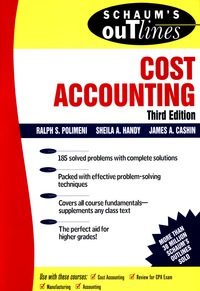Answered step by step
Verified Expert Solution
Question
1 Approved Answer
GOALS AND OBJECTIVES To review the nature and usage of job - order or job costing as a system for accumulation. To review how normal
GOALS AND OBJECTIVES
To review the nature and usage of joborder or job costing as a system for accumulation.
To review how normal costing for overhead is used as a part of job costing.
To review how job costing applies to both financial reporting and internal planning, controlling and decision making.
CALIFORNIA COMPANY
Uses job order costing. At the start of the year, January the company had workinprocess which consisted of the following jobs and costs:
Job Job Job
Direct materials $ $ $
Direct labor
Applied overhead
During the first quarter more jobs were started Job Job and Job The following cost information is available for costs incurred during the month of January:
Job Job Job Job Job Job
Direct materials
Direct labor
During the quarter, jobs and were all completed. In addition, Jobs and were sold before the end of the quarter.
The company uses normal costing and closes under and overapplied overhead directly to Cost of Goods Sold. There was no finishedgoods inventory at the start of the period. Selling and administrative expenses totaled $ for the quarter. Actual overhead for the quarter totaled $ The company had no other nonoperating gains or losses. Assume a tax rate of
Required:
The company applies overhead based on direct labor cost compute the predetermined overhead rate.
POHR Applied Overhed
Direct Labor Cost
r
WHY would the company use normal costing versus actual costing?
Using a predetermined overhead rate based on estimations, normal costing enables businesses to consistently apply overhead to jobs all year long. It facilitates the prompt provision of job cost information, evens out seasonal variations in overhead expenses, and makes budgeting and planning simpler. While Real overhead rates are used in actual costing, which makes it challenging to price works and make timely judgments because they can change and may not be known until the end of the period.
Set up summary work in process Taccounts and job cost sheets for each job for the first quarter.
Post all first quarter costs to the summary work in process AND individual job cost sheets. When posting, make sure you do a total column for each cost element and ONLY POST TOTALS to the general ledger T accounts.
Calculate the ending balance for each job as of March
Calculate the ending balance in workin process as of March
Calculate the cost of goods manufactured for the quarter.
Calculate the normal unadjusted cost of goods sold for the quarter. Calculate the adjusted cost of goods sold. WHY are they different? Why do we need both? What is the reason for the normal cost of goods sold?
During the quarter, did finished goods inventory increase or decrease AND by how much? WHY?
Compute the overunderapplied overhead for the quarter.
Assuming that the company prices its jobs at full cost plus calculate the sales revenue for the quarter.
Prepare an income statement for the first quarter.
Please answer from and shows the work please, thank you.
Step by Step Solution
There are 3 Steps involved in it
Step: 1

Get Instant Access to Expert-Tailored Solutions
See step-by-step solutions with expert insights and AI powered tools for academic success
Step: 2

Step: 3

Ace Your Homework with AI
Get the answers you need in no time with our AI-driven, step-by-step assistance
Get Started


